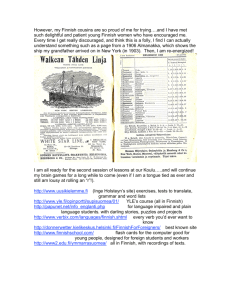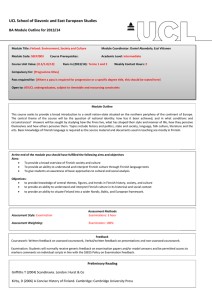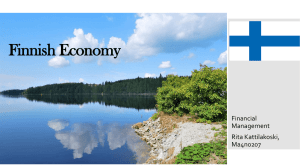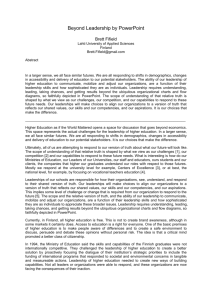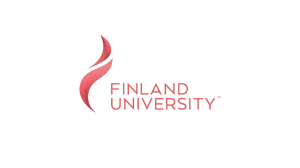Finnish Media Education
advertisement
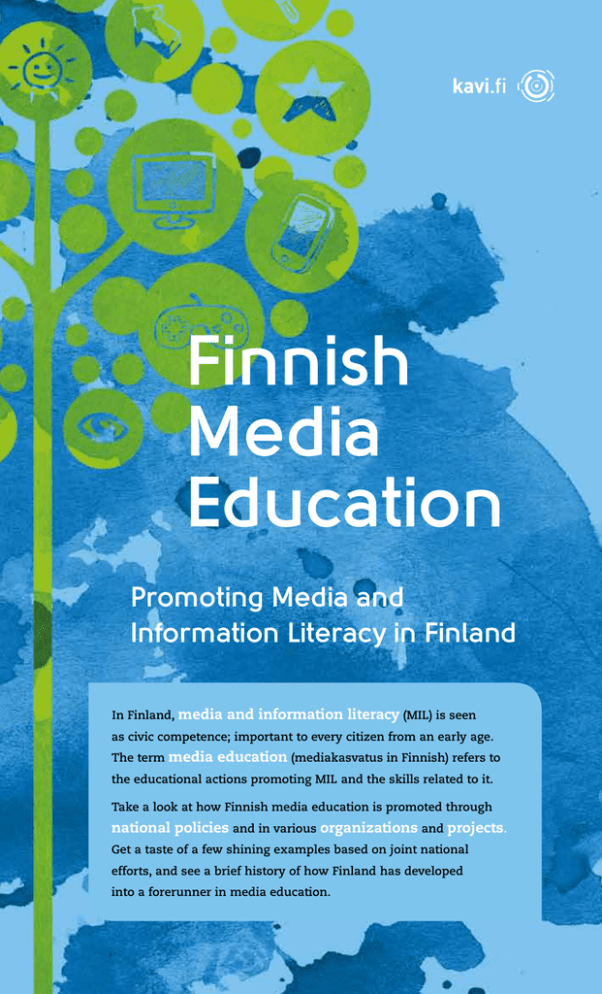
Finnish Media Education Promoting Media and Information Literacy in Finland In Finland, media and information literacy (MIL) is seen as civic competence; important to every citizen from an early age. The term media education (mediakasvatus in Finnish) refers to the educational actions promoting MIL and the skills related to it. Take a look at how Finnish media education is promoted through national policies and in various organizations and projects. Get a taste of a few shining examples based on joint national efforts, and see a brief history of how Finland has developed into a forerunner in media education. M edia education and its benefits are seen in a very broad sense in Finnish policies. Media education enhances versatile literacy competencies, and thanks to media education, people in all age groups possess better skills for tackling everyday life, participating in society and developing as individuals. Ensuring a stronger position for media education is one of the strategic aims of the Ministry of Education and Culture. The Ministry promotes media literacy through allocating resources, providing relevant information and developing legislation, including educational, cultural, youth and art policies. Other governmental bodies support MIL as well, for example, the Ministry of Justice addresses MIL from the viewpoint of inclusion and as part of a democratic education. The Finnish Competition and Consumer Agency works from the perspective of consumer education, producing media related material based on consumer awareness information and education. Good Media Literacy – National Policy Guidelines In 2013, the Ministry of Education and Culture prepared cultural policy guidelines to promote media literacy among children and adolescents. These guidelines have been designed in collaboration with organizations from different parts of society to cater to a wide range of stakeholders in media education. The four goals of media education in Finland for 2013–2016, from the policy guidelines: Everyday media education is child and adolescent-centred, and of high quality. Sustainable structures promoting media literacy are achieved through legislation, financial resources, and national and local level steering. Activities and various stakeholders in media education profile themselves, networks are reinforced, and new partnerships are created. Finland plays an active role in global media education activities. The importance of MIL and skills related to it are included in other policies, such as: • Finland’s Digital Agenda 2011–2020 • Policies for Audiovisual Culture • Public Library Policy 2015 • Child and Youth Policy Programme 2012–2015. KAVI – The Finnish Media Education Authority Finland is one of very few countries with a govern­mental media education authority. The National Audiovisual Institute (KAVI), with its Department for Media Education and Audiovisual Media (MEKU), has a legal task to promote media education, children’s media skills and the development of a safe media environment for children. MEKU also supervises the provision of audiovisual programmes. KAVI is a subordinate of the Ministry of Education and Culture and acts in cooperation with stakeholders. Media Education Goes National In Finland, the importance of media and information literacy is emphasized in several national policies, and media education is promoted by a governmental authority. National level goals for media education were drawn up in 2013. Media Education in Finnish Educational System T he Finnish educational system has often been seen as one of the best in the world. All children and young people have an equal opportunity, free of charge, for a basic education, and the teachers are highly educated. Aspects of media and information literacy are connected to several different subjects studied at the schools. Communities, schools and teachers in Finland have a lot of freedom in planning educational actions. This creates opportunities in teaching and learning in locally meaningful ways. P romoting media and information developing legislation in this sector. The literacies starts at a very early Finnish National Board of Education, a age in the Finnish education state institution under the authority of system. National Core Curricula the MoEC, is responsible for curricula for Pre-Primary Education and Basic development. Education include transversal competence areas called Multiliteracy and Information and communication technologies (ICT). The curriculum for Upper Secodary Higher Education and Media Education Research Education includes cross-curricular themes Multiliteracy and Media as well Master’s degree programs in media as Technology and Society. Competences education are available in two Finnish related to MIL are practiced across different universities, the University of Lapland subjects and contents of curricula as part and University of Tampere, which both of these wide competence areas. have professorships in media education. In these competence areas, MIL Additionally, smaller scale study modules plays an important part. For example in media education are available in several Multiliteracy highlights the importance Finnish universities and universities of of multimodality, and the critical abilities applied science. both to interpret and to produce different The field of media education research is media. In the curricula, ICT is seen both as multidisciplinary and covers a great variety the target of and as a tool for education. In of topics. Related research is being done in the competence area of ICT, information the majority of Finnish universities, most skills and exploratory and creative learning often in the departments of educational are emphasized. Media culture is seen as sciences, but also in humanities and social an important resource and environment sciences, for example. for learning across the disciplines. In the curricula for Vocational Upper Overall, the research has focused on media education practises and theories, Secondary Education, media and and media and the usage of media information literacy competences are from different theoretical perspectives. mainly integrated in mother tongue and Most often, the focus of the research in ICT in mathematic and science subjects. Finland has been on how information and Special attention is paid to work related communications technology support the media competences. teaching-studying-learning processes*. The Ministry of Education and Culture (MoEC) has supported the development of MIL and media education pedagogies through resource allocation and * Media Education Research in Finland: A Literature Review Pekkala, Pääjärvi, Palsa, Korva & Löfgren 2013. www.kavi.fi/meku/julkaisut Significant media educational work takes place all over the country, and Finland benefits from a rich variety of operators in the field. There are almost 100 different organisations promoting MIL in Finland. This is in addition to media education carried out in formal education, youth work, libraries and other public cultural services. The Many Players in the Field of Media Education T he large number of The Finnish Society on Media Education organisations contributing to is a key organisation among NGOs in media education is impressive the media education field, especially in for a small country like Finland. bridging the gap between research and Most often, organisations are promoting practical activities. Several other operators media and information literacy as a part in media education are also members of of their work, and integrating it into their this society. specific areas of expertise. The Finnish Library Association is very Here is a summary of the main active in the field of media education as organisations promoting media education: well. Libraries, in general, have been major The National Audiovisual Institute under players in areas such as game education the Ministry of Education and Culture is the and supporting elderly people with media Finnish media educational authority, with related skills. a legal task to promote media education. Child and youth organisations promote Among governmental agencies, the media literacy to ensure the welfare and National Board of Education is a key actor participation of children and adolescents. with its role in developing education in Finland. In addition, the Ministry of Justice From the perspective of MIL, the most and the Finnish Competition and Consumer active national services of youth work Agency contribute to MIL as part of their are the Development Centre of Youth duties. Information and Counselling (Koordinaatti), the National Development Centre for Online Youth Work (Verke), and the Finnish Youth are promoting film education as part Research Network. of media education. The National Audiovisual Institute enhances film Active NGOs include, for example, the education and the status of Finnish Mannerheim League for Child Welfare, audiovisual culture as part of its legal Development Centre Opinkirjo, Save the duties. Children Finland and the Finnish Parents’ League. NGOs often have strong regional Promoting media literacy is also networks, which is very important for becoming more widespread in media Finland as a sparsely populated country companies and associations. The with long distances. Finnish National Broadcasting Company (YLE) has provided media educational Organisations promoting art and culture projects and materials for several years, have been very active and important but many private companies are also operators in the field of media education active in supporting and providing for decades. The national network of media education. children’s culture centres brings together a number of organisations that have media The Finnish Newspaper Association has education in their regional activities. a long history of media education, and the Federation of the Finnish Media Film education, especially, has a long and Industry, Finnmedia, has chosen the continuous history in Finland. For example, development of the media literacy of Koulukino (School Cinema Association) children and adolescents as its strategic and the Media Education Centre Metka and societal goal. Finnish MIL experts have an active role as international co-operators in terms of research, practise and policy development. MIL is promoted in Nordic, European and global levels, for example via projects coordinated by The European Union, The Council of Europe and UNESCO. Don’t hesitate to contact Finnish professionals when looking for MIL partnerships! Teamwork: The Best Practice of Finnish Media Education In the broad and versatile field of Finnish Media Education, there are simply too many great models to choose from as examples of best practices. Nevertheless, it’s easy to name one feature that many good practises have in common: cooperation between different organisations and actors. Here are some successful examples of Finnish Media Education practises based on joint efforts. Media Literacy Week The aim of the annual MLW in February is to raise awareness and promote the importance of media literacy and media education. Approximately 40 organizations (covering ministries, governmental agencies, telecom operators, data security companies, media companies and NGO’s) are engaged in the MLW every year. Themes, campaigns, awareness materials and events for MLW are planned in co-operation with participating stakeholders. The MLW also encourages schools and other local organizations to arrange events of their own. The National Audiovisual Institute carries the main responsibility for Media Literacy Week, but it is a joint effort of all participating organizations. www.mediataitoviikko.fi National Games Day The NGD consists of a group of events that discuss the merits, meanings and influences games can have on players. This day also promotes fact-based public debate about digital games, and encourages children and adults to play together. Activities during the week leading up to the NGD in November are organized by public libraries, schools, youth centres, museums and other organisations all around the country. The NGD is coordinated by the Finnish Game Educators’ Network, which includes professionals from governmental agencies, media companies, municipalities and NGOs. www.pelipaiva.fi Media Education Forum for Professionals The annual Media Education Forum in October is a national meeting place for researchers, decision-makers, governmental officers, and all other professionals working with issues related to media education. The forum aims to support sector-wide partnerships and co-operation within the field and discusses promoting media education in Finland. The Forum is organized by the National Audiovisual Institute. From the Grassroots Level to Mainstream Media –The Youth Voice Editorial Board The Youth Voice Editorial Board works in the metropolitan area as a news producing group delivering material to different media. The aim is to support young people in producing media content, and to activate and enable young people to have public discussions in the media about issues which are important to them. Young people in the Editorial Board are trained to write articles and produce TV programmes with the help of professionals and leading journalists. Cooperation with organisations such as the National Broadcasting Company (YLE) and the biggest national newspaper (Helsingin Sanomat) guarantees visibility in the mainstream media. This media and democracy educational work was rewarded with the Democracy Prize by The Ministry of Justice in 2012. Twenty Years of Good Practice – Newspaper Week Newspaper Week is a week of cooperation between newspapers and schools, during which the Finnish Newspaper Association’s member newspapers supply schools and kindergartens with free copies of their publications. These newspaper materials can be used in different ways, depending on different subjects. The fundamental idea of the Newspaper Week is to provide all schoolchildren with the opportunity to become familiar with newspapers. Together, the association and member newspapers direct, monitor and develop the wide range of events held during the week in February of each year. The Newspaper Week was arranged for the first time in 1994. Stay Informed about Finnish Media Education! The Finnish Society on Media Education provides a portal of national and international media educational issues and publishes a newsletter (also in English). The portal and newsletter provide information on the latest projects, events and research going on in Finland. www.mediaeducation.fi From Mass Media to the Digital Age A Brief Look at the History of Media Education in Finland 1950s In the , questions about mass communication and, especially, the effects of films on the individual and on society were discussed both academically and in public. Educational approaches regarding films were often protective or emphasized the distinction between ‘bad’ entertainment and propaganda, on the one hand, and ‘good’ art, on the other. 1960s During the , the winds of liberation shaped media education. In art education, themes like war, sex and equality were scrutinised by using materials from mass media and popular culture. Television entered Finnish households. 1970s began a new, more systematic era in Finnish (mass) media education. The observation and interpretation of media, critical and selective “adoption”, and understanding the modes of expression and narratives of information technology were called for. This approach was implemented in the comprehensive school curricular principles for the first time in 1972. The different phases of Finnish media education have, for their part, contributed to the development and identity of Finland as a nation. Educating the masses has played a vital role in building the participatory citizenship of Finland. Today, mobile and digital cultures are breaking new ground in media education. For a more comprehensive review: Kupiainen, Sintonen & Suoranta 2009. Decades of Finnish Media Education. www.mediaeducation.fi/publications 2010s new millennium 1980s The saw the rise of new kinds of audiovisual media, such as Music Television and home videos. Media education had to answer to the needs of a new generation and youth movement, and a powerful perspective entered media education through media culture research. 1990s In the the focus of media education turned from mass media to communication, including more aspects of individual expression and production. Computers, the everyday use of the internet, as well as mobile phones affected society and media education. The use of communication and information technology and virtual learning environments became more and more common in educational institutions. The both expanded and fragmented the field of media education. Its importance was recognized more strongly at the governmental level, and Finland became one of the pioneering countries for promoting media literacy among young children. The NGO Finnish Society on Media Education, was founded by researchers and practitioners to support and develop the field. In research, children’s and young people’s relationships with media were highlighted. Media education became less bound by certain technologies, even though the use of the internet and social media was widely discussed. The have already seen the strengthening of the position of media education on a national level. Media education is included in several governmental policies. Successful media education activities enhance the well-being and participation opportunities of all, especially children and young people. A governmental media education authority was founded under the Ministry of Education and Culture in 2012. What’s next? The hot topics right now include the growing significance of media in people’s lives, through trends like mobile media technologies, and the accelerating digitalisation and media convergence. The breakthrough of digital games as “everyman’s media” calls for game education. The need for media education among the adult population, and especially the elderly, is growing rapidly. Research on the impacts of media education is gaining more interest as well. Published by National Audiovisual Institute, Finland Lay out Tiina Aaltonen | gra & grappo Contact information National Audiovisual Institute/MEKU P.O. Box 16 | Sörnäisten rantatie 25 A 00501 Helsinki Finland Tel. +358 295 338 000 www.kavi.fi/meku




